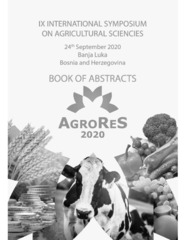Приказ основних података о документу
The effect of fall sown different cover crops on popcorn weediness
| dc.creator | Dolijanović, Željko | |
| dc.creator | Momirovic, Nebojsa | |
| dc.creator | Oljača, Snežana | |
| dc.creator | Simić, Milena | |
| dc.creator | Dragičević, Vesna | |
| dc.creator | Moravcevic, Djordje | |
| dc.date.accessioned | 2022-10-14T05:42:55Z | |
| dc.date.available | 2022-10-14T05:42:55Z | |
| dc.date.issued | 2020 | |
| dc.identifier.isbn | 978-99938-93-63-9 | |
| dc.identifier.uri | http://rik.mrizp.rs/handle/123456789/1005 | |
| dc.description.abstract | The use of cover crops can be considered as an effective method, especially in sustainable and organic agriculture through weed control and reducing herbicide use, improving soil and increasing main crop yield. An experiment was conducted using randomized complete block design with four replications in 2015–2016 growing seasons, at the Experimental Field of Maize Research Institute in Zemun Polje. Cover crops (fall–winter species) were considered as the main factor (common vetch, field pea, winter oats, fodder kale), mixtures common vetch and field pea with winter oats, dead organic mulch and traditional variant, without coverage on biomass. Green biomass of the cover crops was incorporated in the soil, and treatments with favorable establishment and above-average biomass yields tended to suppress weeds by showing lower weed dry matter and weed numbers. The most common species of weeds in popcorn at the investigated locality were Sorghum halepense L. Pers., Datura stramonium L., Chenopodium album L., Amaranthus hybridum L., Solanum nigrum L., Amaranthus retroflexus L., Amaranthus albus L., Convolvulus arvensis L., and Hibiscus trionum L. Significantly higher weed infestation was observed in the second year of the investigation and the reasons were unfavorable weather conditions, especially high air temperature and unequal distribution of precipitation. The highest weed control efficacy within the cover crop species was established in 2016 by mixtures of legume crops and winter oats. The results showed very significant difference between treatments, especially in terms of fresh biomass of weeds, thus the lowest weed biomass was related to mixed legume species (common vetch and field pea) and winter oats (260 and 250,78 g), while on the control variants (dead organic mulch and traditional variant) 562.15 and 540, 46 g was measured. The number of weed species and number of plants per species was also the highest in the control variants. | sr |
| dc.language.iso | en | sr |
| dc.publisher | Banja Luka : University of Banja Luka, Faculty of Agriculture | sr |
| dc.rights | openAccess | sr |
| dc.rights.uri | https://creativecommons.org/licenses/by/4.0/ | |
| dc.source | 9. International symposium on agricultural sciences "AgroReS 2020", Banja Luka, 24.09.2020. – Book of abstracts | sr |
| dc.subject | weeds | sr |
| dc.subject | popcorn | sr |
| dc.subject | cover crops | sr |
| dc.subject | coverage of soil | sr |
| dc.title | The effect of fall sown different cover crops on popcorn weediness | sr |
| dc.type | conferenceObject | sr |
| dc.rights.license | BY | sr |
| dc.citation.spage | 47 | |
| dc.citation.epage | 47 | |
| dc.identifier.fulltext | http://rik.mrizp.rs/bitstream/id/4850/9.2020.pdf | |
| dc.identifier.rcub | https://hdl.handle.net/21.15107/rcub_rik_1005 | |
| dc.type.version | publishedVersion | sr |


